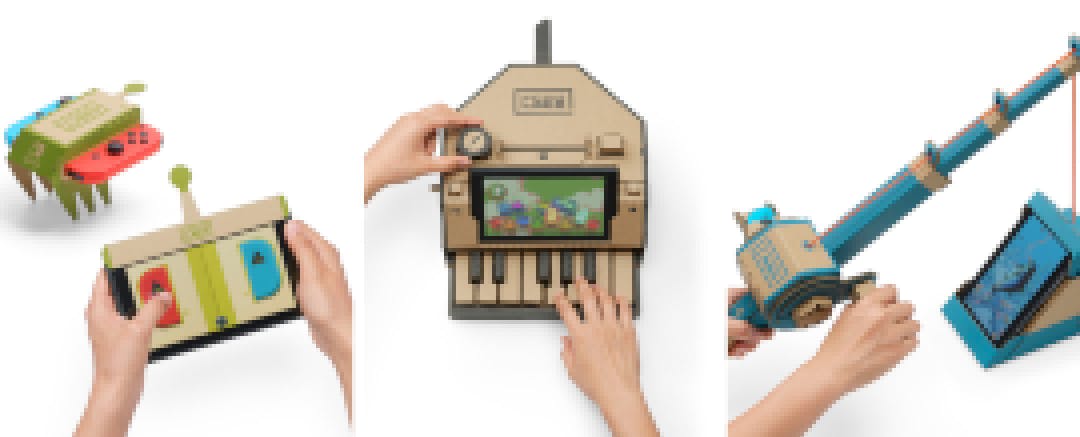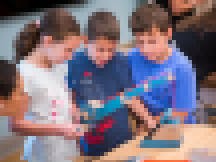All those ‘90s kids who used to try sneaking their Game Boys into class and playing discreetly under their desks—to no avail, of course—may soon be feeling like they were born in the wrong decade.
The gaming devices aren’t being treated as contraband anymore, at least not in the 100 K-12 schools that have welcomed Nintendo products into their classrooms this year to help students develop collaboration, creativity, critical thinking and problem-solving skills.
The classroom program, which began in fall 2018 and runs through the spring, pairs Nintendo technology with a curriculum designed by the Institute of Play to create a STEM-focused, hands-on learning experience that combines digital and physical elements.
It started as a small pilot in 11 schools last September, says Arana Shapiro, executive director at the Institute of Play, a nonprofit that builds learning experiences around game design. But after receiving immediate and emphatic feedback that teachers enjoyed using Nintendo Labo with their students, the two organizations decided to expand the scope to 100 teachers in 100 different U.S. schools—this time, accompanied by a teacher guide filled with lesson plans, instructions and ideas.
More than 700 teachers applied to be part of the 2018-2019 rollout, which required a commitment to spending 15-20 hours of total class time to the experience and to working with kids between ages 8 and 11.
The 100 educators selected received a copy of the teacher guide the nonprofit had produced, then joined a webinar where they learned the ins and outs of Nintendo Switch, a gaming console, and Nintendo Labo, a cardboard-based variety kit filled with do-it-yourself activities that build on the Switch. Representatives at both Nintendo and the Institute of Play introduced the product as well as some of the activities the educator would be able to lead with their students.
Adam Renard, a fourth-grade science and math teacher in the Forest Hill School District in Cincinnati, Ohio, is one of the educators involved in the Labo program. He remembers hearing about it and eagerly submitting an application. “When we found out we got it, there was a lot of rejoicing among five of us on staff who understand what it meant and what we could do with it,” he tells EdSurge.
Renard, like each teacher in the program, received two Nintendo Switches and two Labo kits. The kits include cardboard materials for five different “toy-con” creations—an RC car, a fishing rod, a house, a motorbike and a piano—and enough of it so each student in the class can get a chance to build, says Shula Ehrlich, the creative design lead at the Institute of Play.

The projects vary in difficulty, starting with the simplest creation, an RC car. A lesson plan in the teacher guide explains how to build the RC car and suggests roles each student in the class can play—one drives the Switch, another folds the cardboard into its proper shape and a third might orchestrate the process and keep time. When the RC car is ready, they can build obstacle courses for other teams’ cars and then take turns navigating.
The most common feedback Ehrlich hears from teachers is that Labo gets kids working closely with one another. “The collaboration piece is huge,” she says.
That’s been Renard’s experience. His students started with the RC car, as recommended, and, working with partners, used the template provided to put it together. When the cars were complete, “they went wild,” he says. “And just having all 20 kids in my classroom cheering for each other, it was such a neat opportunity to see kids who don’t commonly work together come and encourage each other and work toward a common goal.”
Labo inspired and sparked some creativity in Renard, too. He didn’t want the fun—or the challenge—to stop, so he decided to call up a nearby pizza restaurant to see if they had any cardboard to spare. The manager gave him 100 pizza boxes, which they used to recreate the RC car—this time, without looking at the template.
Using the pizza boxes, “the kids had to figure out how to recreate shapes, how to outline the material and try to cut it out,” Renard says. “They were so proud of themselves.”
A K-2 school in the Mohonasen School District in upstate New York has had similarly positive results with its special education students, says Bill Vacca, the assistant principal at Bradt Primary School.
“It’s taken off like nothing I’ve ever seen before,” he says.
The special-ed students were able to put together the RC car, with some help from their teachers. Then something amazing happened, Vacca says. A group of kindergarteners built the fishing rod on their own, then they helped the special-ed students construct theirs. The students worked together to “go fishing,” and one of the special ed students caught a fish, creating an exciting, emotional scene in school that day, Vacca describes.

“The teachers in our building, they’re going nuts,” Vacca says. They’ve already presented about Labo in front of other school districts. Two of them are holding a 90-minute professional development session at the end of March focused on how to use Labo with students from kindergarten to fifth grade.
The district is even thinking about applications for high schoolers, Vacca says.
“This is perfect for our students. It motivates them,” he says. “That learning is contagious. If you have a student who hates spelling and you can’t get him to focus on it, [and] you’ve tried everything else, you can give him a Switch and I guarantee you 100 percent of kids would jump at doing that.”
The teacher guide doesn’t include much for assessment, Ehrlich says, mostly because the Institute of Play wants educators to use Labo to cultivate skills that standardized tests can’t measure. It does, however, encourage the use of “exit tickets” and reflections, as well as small group and class discussions.
The idea of Labo isn’t to take the place of another activity or lesson, Ehrlich says, but rather to be a fun, play-based alternative for engaging students around skills that are increasingly in demand.
“I don’t think it will replace content or learning experiences tit for tat, but more supplement them,” she says. “For us, it’s about how Labo supports 21st century learning—critical thinking, communication, cooperation and design.”
Vacca has seen these skills come out in students who are using Labo, and for that reason, he wants to “double, if not triple” the number of kits available in his school next year, he says.
The program will wrap up in April, at which time teachers involved will have a chance to provide feedback and ideas about how it can be improved.
“We’ll do iterations and refinement to the teacher guide after that,” Shapiro, the executive director, says, then Nintendo will decide how much to scale the program from there.


